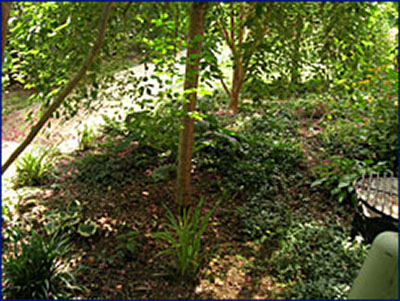Soil
 Soil fertility is determined by nutrients and depends on the clay- to-organic mixture. Soil pH is the relationship of hydrogen (H) ions to hydroxyl (OH) ions which determine whether a soil is acid or alkaline. When these components are equal, the soil is neutral with a pH of 7. When H is higher than OH, the pH is lower and the soil becomes acidic. When H is lower than OH, the pH is high and the soil is alkaline. Calcium and magnesium contribute to alkalinity while hydrogen and aluminum determine acidity. Lime raises the pH and makes the soil alkaline while sulfur lowers the pH and makes the soil acidic. Most garden plants such as azaleas and rhododendrons need a pH between neutral to acidic. Instead of adjusting soil pH to match a plant’s need, rather adapt plants to the USDA Plant Hardiness Zone in which you live.
Soil fertility is determined by nutrients and depends on the clay- to-organic mixture. Soil pH is the relationship of hydrogen (H) ions to hydroxyl (OH) ions which determine whether a soil is acid or alkaline. When these components are equal, the soil is neutral with a pH of 7. When H is higher than OH, the pH is lower and the soil becomes acidic. When H is lower than OH, the pH is high and the soil is alkaline. Calcium and magnesium contribute to alkalinity while hydrogen and aluminum determine acidity. Lime raises the pH and makes the soil alkaline while sulfur lowers the pH and makes the soil acidic. Most garden plants such as azaleas and rhododendrons need a pH between neutral to acidic. Instead of adjusting soil pH to match a plant’s need, rather adapt plants to the USDA Plant Hardiness Zone in which you live.
Sixteen elements are essential for an ideal soil. Three—carbon, hydrogen and oxygen—come from the atmosphere and water. The three most deficient elements in the soil are nitrogen (N), phosphorous (P) and potassium (K), which can be found in bagged fertilizers at a nursery. When you see N-P-K on the bag, it will have numbers which signify the weighted ratio of these elements. Nitrogen promotes leaf growth, Phosphorus promotes root, flower and fruit growth while Potassium promotes stem and root growth. Additional soil macronutrients are calcium, magnesium and sulfur. Reduced nitrogen in the soil will turn the leaves yellow. This deficiency will also yield leaf and stem growth but retard fruit and flower production.
Improve soil fertility with organic matter such as compost or manure, which increases humus and invites microorganisms, like earthworms, which will till the soil. Humus forces soil particles together, allowing spatial passages for oxygen and water, which improve drainage. Devoid of oxygen, plant roots rot.
